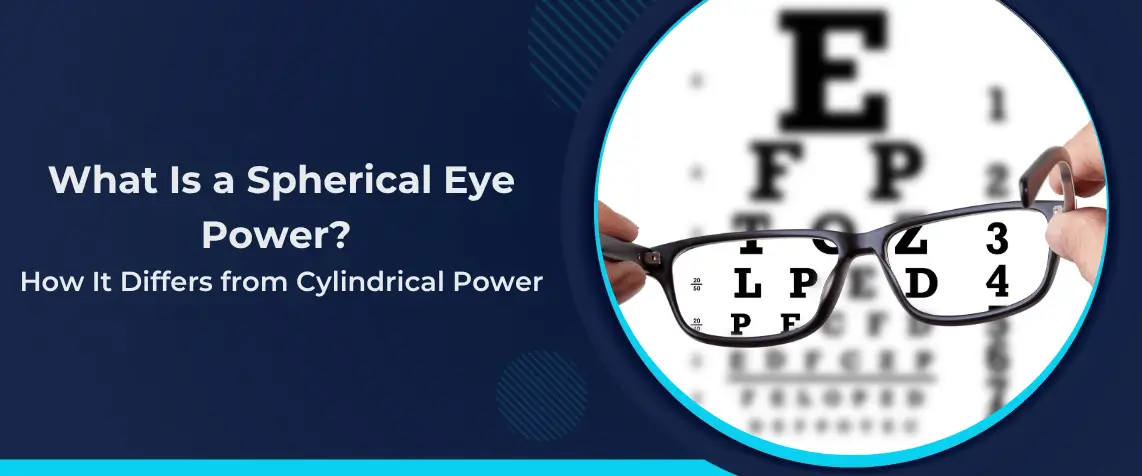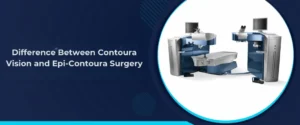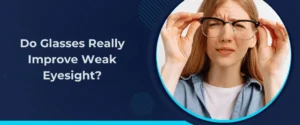When you schedule a visit to an eye specialist for a routine eye test, your prescription typically includes numbers in different categories – spherical, cylindrical, and sometimes axis. We understand these terms can be confusing for many people. But understanding exactly what different eye powers mean can help you make an informed decision about your eye health.
In this blog, we will break down the meaning of spherical eye power, cylindrical eye power, and the key differences between the two.
What is Spherical Power?
Spherical eye power refers to the degree of correction needed to treat common refractive errors such as myopia (nearsightedness) and hyperopia (farsightedness). It is referred to as “spherical” as the lens has the same curvature from all directions – like an actual sphere.
Here’s how it works:
- Negative spherical power (-) is used for vision correction in case of myopia. A myopic person can see nearby objects but has difficulty viewing distant objects clearly.
- Positive spherical power (+) is used for vision correction in hyperopia. A hyperopic person can see distant objects clearly but has difficulty viewing nearby objects clearly.
Spherical lenses help bend light in all directions so that it can focus correctly on the retina, thus providing clear vision. If your prescription shows a spherical number (for instance, -2.00 or +1.50), this is an indication of a myopic or hyperopic condition and not astigmatism.
What is Cylindrical Power?
Cylindrical eye power is used to correct conditions such as astigmatism. This is when the eye’s cornea or the lens has irregular curvatures on its surface. The irregular curvatures of the cornea/lens prevent light from focusing at a single point on the retina, which leads to distorted or blurry vision.
Here’s how it works:
- Cylindrical eye power is represented along an axis.
- Cylinder or CYL indicates the degree of correction required.
- The axis indicates the angle where astigmatism is located (0° to 180°). So, if your prescription is -1.25 CYL at 90°, that means your eye needs cylindrical correction at 90° in a particular direction.
Difference Between Spherical and Cylindrical Power
Although both spherical and cylindrical powers are meant to correct refractive errors, they serve different purposes. Here’s a tabular representation of the difference between spherical and cylindrical power:
| Feature | Spherical Power | Cylindrical Power |
| Purpose | Corrects myopia or hyperopia | Corrects astigmatism |
| Lens Shape | Uniform shape | Different curvature in specific meridians |
| Prescription Symbol | SPH | CYL (with Axis) |
| Vision Issue | Blurred near or distant vision | Blurred or distorted vision at all distances |
| Correction Type | Single-point focus on retina | Focuses light along one meridian |
What is a Spherical Cylindrical Lens?
Many individuals require both spherical and cylindrical vision correction. A spherical cylindrical lens is designed to correct myopia/hyperopia and astigmatism simultaneously. These lenses are meant to combine spherical and cylindrical powers into a single prescription.
This means the individual may have nearsightedness or farsightedness along with astigmatism and requires correction at a specific angle. Spherical cylindrical lenses can be used in specs, contact lenses, or in intraocular lens implants.
How Are Eye Powers Tested?
There are multiple tests that help optometrists or ophthalmologists assess the eye power and refractive error:
- Phoropter
- Retinoscope
- Keratometer
- Autorefractor
Through the help of these diagnostic tools, specialists determine the exact spherical and cylindrical powers required for clear vision.
Treatment Options for Spherical/Cylindrical Vision
Both spherical and cylindrical vision issues can be treated through:
- Eyeglasses
- Contact Lenses (Toric lenses for astigmatism)
- Refractive Surgery
- Intraocular Lens (IOL) Implants
Signs You Should Get Your Eyes Checked
You must seek medical help from a trusted eye specialist if you experience any of the following symptoms:
- Blurred/unclear vision
- Seeing double/double vision
- Eyeglasses not working well
- Excessive eye rubbing or squinting
- Persistent headaches or discomfort
At Sohana Eye Hospital, our expert team of the best eye specialists in Mohali makes use of the most advanced diagnostics for the most accurate prescriptions and personalised treatment plans.
Frequently Asked Questions
1. How to tell if I have myopia/hyperopia or astigmatism?
The difference is simple! If you experience blurry distant vision, you have myopia. If you are unable to view nearby objects clearly, you have hyperopia. And lastly, if you experience blurry and distorted vision regardless of the distance, you might be suffering from astigmatism. If you experience any visual discomfort, visit an optometrist or eye specialist for a proper diagnosis.
2. When do I need to see a doctor for vision difficulties?
You must visit an eye specialist if you are experiencing significantly blurred or distorted vision, if the vision difficulties are causing significant distress, or if your regular activities are being significantly affected.
3. Why does astigmatism cause blurry vision both near and far?
Astigmatism is caused by the irregular curvatures of the cornea. This causes any light entering the eye to bend more than it should. This results in the light rays either falling short of the retina or falling too far behind it. This is why people with astigmatism experience blurry vision at all distances.





